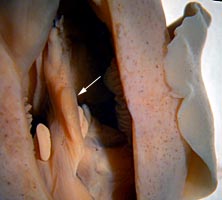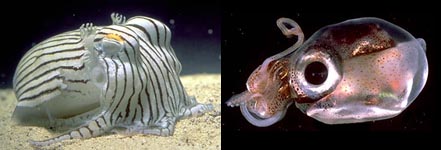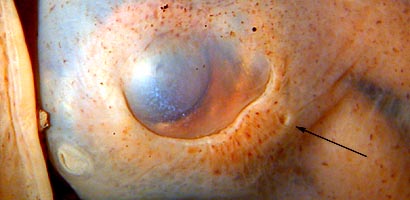Sepiolida
Michael Vecchione and Richard E. Young


This tree diagram shows the relationships between several groups of organisms.
The root of the current tree connects the organisms featured in this tree to their containing group and the rest of the Tree of Life. The basal branching point in the tree represents the ancestor of the other groups in the tree. This ancestor diversified over time into several descendent subgroups, which are represented as internal nodes and terminal taxa to the right.

You can click on the root to travel down the Tree of Life all the way to the root of all Life, and you can click on the names of descendent subgroups to travel up the Tree of Life all the way to individual species.
For more information on ToL tree formatting, please see Interpreting the Tree or Classification. To learn more about phylogenetic trees, please visit our Phylogenetic Biology pages.
close boxIntroduction
Members of the Sepiolida are short (mostly 2-8 cm ML), broad cephalopods with a rounded posterior mantle.
Brief diagnosis
A sepioid ...
- with a short, rounded body.
- without a cuttlebone.
Characteristics
- Head
- Eye pore outside of ventral eyelid.
- Mantle
- Dorsal margin fused to, or free, from head.
- Ventral mantle adductor present.
- Fins
- Fins broad (length ca. less than two times, usually equal to, individual fin width).
- Posterior attachment of fins broadly separated from each other.
- Shell
- Shell a thin or rudimentary gladius or absent.


Figure. Ventral view of mantle cavity of Rossia sp., preserved. Arrow points to the cut surface of the ventral mantle adductor where it had attached to the ventral mantle wall. Anteriorly the adductor muscles pass to either side of the intestine. Photograph by R. Young.
About This Page
Michael Vecchione

National Museum of Natural History, Washington, D. C. , USA
Richard E. Young

University of Hawaii, Honolulu, HI, USA
Page copyright © 2019 Michael Vecchione and Richard E. Young
 Page: Tree of Life
Sepiolida .
Authored by
Michael Vecchione and Richard E. Young.
The TEXT of this page is licensed under the
Creative Commons Attribution-NonCommercial License - Version 3.0. Note that images and other media
featured on this page are each governed by their own license, and they may or may not be available
for reuse. Click on an image or a media link to access the media data window, which provides the
relevant licensing information. For the general terms and conditions of ToL material reuse and
redistribution, please see the Tree of Life Copyright
Policies.
Page: Tree of Life
Sepiolida .
Authored by
Michael Vecchione and Richard E. Young.
The TEXT of this page is licensed under the
Creative Commons Attribution-NonCommercial License - Version 3.0. Note that images and other media
featured on this page are each governed by their own license, and they may or may not be available
for reuse. Click on an image or a media link to access the media data window, which provides the
relevant licensing information. For the general terms and conditions of ToL material reuse and
redistribution, please see the Tree of Life Copyright
Policies.
- First online 21 August 2004
- Content changed 26 March 2019
Citing this page:
Vecchione, Michael and Richard E. Young. 2019. Sepiolida . Version 26 March 2019 (under construction). http://tolweb.org/Sepiolida/23872/2019.03.26 in The Tree of Life Web Project, http://tolweb.org/








 Go to quick links
Go to quick search
Go to navigation for this section of the ToL site
Go to detailed links for the ToL site
Go to quick links
Go to quick search
Go to navigation for this section of the ToL site
Go to detailed links for the ToL site